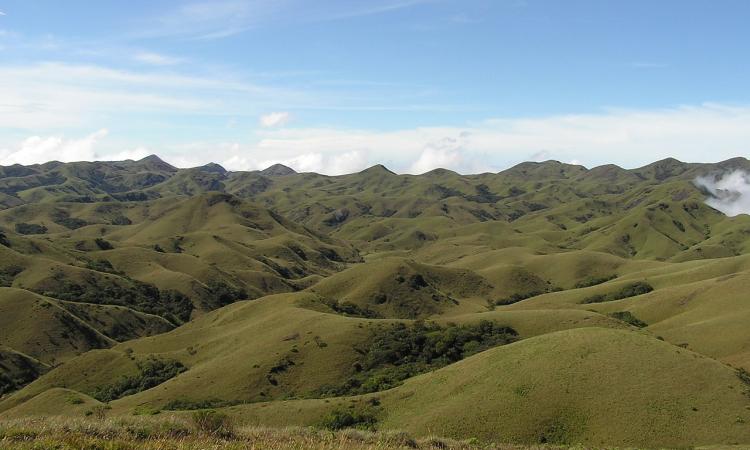
Erratic rainfall patterns and the risk of floods in mountain landscapes
Climate change has been giving rise to extreme events, especially rainfall worldwide. Extreme rain events (ERE) can often lead to destructive floods that cause extensive losses to lives and property. During heavy rains, the soil can get saturated and the excessive overland flow can result in higher and quicker discharge from the basin. The problem is more serious in mountainous terrains where steep slopes aid the rapid discharge of water and sediments downstream.
Understanding the relationship between rainfall and discharge patterns of basins can greatly help in designing mitigation strategies to prevent floods, argues this paper titled 'Invasion of natural grasslands by exotic trees increases flood risks in mountainous landscapes in South India' in the Journal of Hydrology.
A number of factors such as steepness of slopes, catchment shape and size, drainage density and antecedent moisture influence the rainfall and runoff generated from the basins.
The role of vegetative cover in controlling floods
Vegetative cover can play an important role in controlling the runoff generated from extreme rainfall by aiding infiltration of precipitation into headwater soils. Some types of vegetation add organic matter to the soil and thus help infiltration thus decreasing the amount and velocity of overland flow and erosion.
Studies have shown that replacement of native grasslands with eucalyptus and wattle can reduce stream flows during the dry season. However, the role of invasive alien trees on runoff responses to extreme rainfall events in the wet-season has not been adequately studied.
This paper discusses the findings of a study that looked at the influence of land-cover, canopy cover, and other catchment morphological characteristics on stream discharges in mountainous catchments in Nilgiris, South India during light, heavy, and extreme rain events.
The Nilgiris
Nilgiris form an important catchment area for several perennial tributaries of the Cauvery, which are extensively dammed for power generation, irrigation and drinking water. In 2018 and 2019, Western Ghats experienced heavy rains and heavy floods destroyed several villages and triggered a large number of landslides that caused huge losses and threatened lives and livelihoods in the region.
This excessive runoff generated from the rainfall seems to have been influenced by the vegetation in the area. While the natural vegetation in the Nilgiris includes high altitude montane-rain-forests (sholas) and grasslands, a large number of exotic plants were introduced in these natural grasslands and sholas, mainly wattles, that gradually invaded these natural grasslands.
What are wattles
Wattles are fast-growing erect evergreen trees, growing up to 10 m tall, native to southeastern Australia. Acacia mearnsii, also known as black wattle, is listed as one of the world’s 100 most invasive alien plant species. Wattles increase the rate of evapotranspiration and use high amounts of soil moisture throughout the year resulting in reduced streamflow, especially during dry seasons.

Black wattle, an invasive plant native to Australia (Image Source: Dinesh Valke from Thane, India via Wikimedia Commons)
However, the role of wattle in influencing rainfall-runoff relationships during extreme rainfall events is not known in the Nilgiris region, where the risk of floods has increased in recent years.
The study found that:
Wattle increased the possibility of floods during extreme rainfall events
Extreme rainfall events were more likely to generate flooding from catchments in areas where natural vegetation had been converted to wattle plantation. The study highlights that it is important to prioritise wattle invaded catchments for monitoring which can help the government and downstream communities to be better prepared to deal with floods in the future.
The findings of the study and projected increase in frequency of intense storms due to climate change in the future call for the need to make efforts to control or remove wattle growth and site restoration to reduce impacts of floods in the Nilgiris landscape.
Wattle led to enhanced dry conditions during summer
Exotic plants such as wattle can lead to increase in the rate of evapotranspiration compared to native plants and significantly reduce stream discharge during the dry season. The Government of Tamil Nadu is one of the first states in India to have a policy and management plan for invasive species and their regulation. Wattle has been identified as one of the species of concern.
Regulation of wattle densities and restoration to semi-natural grassland will greatly help to decrease flood risk under climate change as well as reduce transpiration demand in the dry-season and increase stream discharge for ecosystem requirements and hydro-power generation.
Density of wattle plantations affected flood intensity
High density wattle catchments can retain water for a longer duration of time in extreme rainfall events compared with catchments that have lower and intermediate densities of wattle. Further, once established, wattle builds substantial seed banks and rapidly regenerates after removal. This can amplify the hydrologic impact of wattle stands, which unlike the mature wattle stands are likely to have far higher evapotranspiration rates and overland flow.
The paper argues that future flood early warning systems and risk management strategies should take into consideration the differential effects of land-cover such as densities of woody vegetation and catchment properties along with moisture conditions to improve flood forecasting at different rainfall intensities in the region.
/articles/preventing-floods-through-grassland-conservation